Climate Change and Non-Communicable Diseases: A Bibliometric, Content, and Topic Modeling Analysis
Abstract
1. Introduction
2. Materials and Methods
2.1. Selecting the Database
2.2. Selection of Publications
2.2.1. Determination of Search Terms
2.2.2. Filtering
2.2.3. Inclusion and Exclusion Criteria
2.3. Export of Data
2.4. Data Analysis and Reporting
2.4.1. Bibliometric Analysis
2.4.2. Topic Modeling
2.4.3. Content Analysis
2.5. Ethical Approval
3. Results
3.1. Bibliometric Analysis
3.1.1. Trends in Article Publication by Year
3.1.2. Metrics of the Top 20 Journals
3.1.3. Distribution of Articles by Country
3.1.4. Network Visualization of International Collaborations and Author Keywords
3.1.5. Thematic Analysis
3.2. Topic Modeling Analysis
3.2.1. Structural Topic Modeling
3.2.2. Exploring Thematic Categories from Discovered Topics
3.3. Content Analysis
4. Discussion
4.1. Trends in Article Publication by Year
4.2. Metrics of the Top 20 Journals
4.3. Distribution of Articles by Country and International Collaboration
4.4. Network Visualization of Author Keywords
4.5. Thematic Map
4.6. Thematic Evolution
4.7. Topic Modeling Analysis
4.8. Content Analysis
4.9. Limitations and Strengths
5. Conclusions
Author Contributions
Funding
Institutional Review Board Statement
Informed Consent Statement
Data Availability Statement
Conflicts of Interest
Abbreviations
| AR6 | The Sixth Assessment Report |
| CC | climate change |
| DALYs | disability-adjusted life years |
| HDI | Human Development Index |
| IPCC | Intergovernmental Panel on Climate Change |
| LDA | Latent Dirichlet Allocation |
| MCPs | multi-country publications |
| NCDs | non-communicable diseases |
| RQ | research question |
| SCPs | single-country publications |
| SCIE | Science Citation Index Expanded |
| SSCI | Social Science Citation Index |
| SDG | Sustainable Development Goal |
| STM | Subject Topic Modeling |
| UNDP | United Nations Development Program |
| USA | United States of America |
| WHO | World Health Organization |
| WoS | Web of Science |
| WoSCC | Web of Science Core Collection |
| WoS | Web of Science |
| WoSCC | Web of Science Core Collection |
References
- Arfasa, G.F.; Owusu-Sekyere, E.; Doke, D.A. Climate Change Projections and Impacts on Future Temperature, Precipitation, and Stream Flow in the Vea Catchment, Ghana. Environ. Chall. 2024, 14, 100813. [Google Scholar] [CrossRef]
- World Health Organization (WHO). Climate Change. Available online: https://www.who.int/news-room/fact-sheets/detail/climate-change-and-health (accessed on 22 January 2025).
- Campbell-Lendrum, D.; Neville, T.; Schweizer, C.; Neira, M. Climate Change and Health: Three Grand Challenges. Nat. Med. 2023, 29, 1631–1638. [Google Scholar] [CrossRef]
- IPCC Climate Change 2023: Synthesis Report. Contribution of Working Groups I, II and III to the Sixth Assessment Report of the Intergovernmental Panel on Climate Change; Intergovernmental Panel on Climate Change (IPCC): Geneva, Switzerland, 2023. [CrossRef]
- United Nations Transforming Our World: The 2030 Agenda for Sustainable Development. Available online: https://sdgs.un.org/2030agenda (accessed on 25 February 2025).
- Hasan, M. Climate Justice and COP26: A New Perspective on the Climate Crisis. Med. Confl. Surviv. 2022, 38, 242–250. [Google Scholar] [CrossRef]
- World Health Organization (WHO) WHO Director-General’s Statement at the International Court of Justice—Responding to the Climate Change Health Crisis—13 December 2024. Available online: https://www.who.int/director-general/speeches/detail/who-director-general-s-statement-at-the-international-court-of-justice---responding-to-the-climate-change-health-crisis---13-december-2024 (accessed on 19 February 2025).
- Schäfer, M.; Hase, V.; Mahl, D.; Krayss, X. From “Climate Change” to “Climate Crisis”?: Analyzing Changes in Global News Nomenclature from 1996 to 2021. Bergen Lang. Linguist. Study 2023, 13. [Google Scholar] [CrossRef]
- Haueis, P. Climate Concepts for Supporting Political Goals of Mitigation and Adaptation: The Case for “Climate Crisis”. WIREs Clim. Change 2024, 15, e893. [Google Scholar] [CrossRef]
- Costello, A.; Abbas, M.; Allen, A.; Ball, S.; Bell, S.; Bellamy, R.; Friel, S.; Groce, N.; Johnson, A.; Kett, M.; et al. Managing the Health Effects of Climate Change. Lancet 2009, 373, 1693–1733. [Google Scholar] [CrossRef] [PubMed]
- World Health Organization (WHO) WHO Calls for Urgent Action to Protect Health from Climate Change—Sign the Call. Available online: https://www.who.int/news/item/06-10-2015-who-calls-for-urgent-action-to-protect-health-from-climate-change-sign-the-call (accessed on 17 February 2025).
- Centers for Disease Control and Prevention (CDC) How Climate Change Impacts Health. Available online: https://www.cdc.gov/climate-health/php/effects/index.html#:~:text=The%20health%20effects%20of%20these,and%20threats%20to%20mental%20health (accessed on 22 January 2025).
- Paavola, J. Health Impacts of Climate Change and Health and Social Inequalities in the UK. Environ. Health 2017, 16, 113. [Google Scholar] [CrossRef]
- Haines, A.; Kovats, R.S.; Campbell-Lendrum, D.; Corvalan, C. Climate Change and Human Health: Impacts, Vulnerability and Public Health. Public Health 2006, 120, 585–596. [Google Scholar] [CrossRef]
- Zhang, J.-D.; Cheng, X.-F.; Min, S.-H.; Guo, R.-Q.; Wang, R.-N.; He, Y.-T.; Zhang, Y.-L.; Li, B. Burden of Non-Communicable Diseases Attributable to High Temperature in a Changing Climate from 1990 to 2019: A Global Analysis. BMC Public Health 2024, 24, 2475. [Google Scholar] [CrossRef]
- Berry, P.; Enright, P.M.; Shumake-Guillemot, J.; Prats, E.V.; Campbell-Lendrum, D. Assessing Health Vulnerabilities and Adaptation to Climate Change: A Review of International Progress. Int. J. Environ. Res. Public Health 2018, 15, 2626. [Google Scholar] [CrossRef]
- Sweileh, W.M. Bibliometric Analysis of Peer-Reviewed Literature on Climate Change and Human Health with an Emphasis on Infectious Diseases. Glob. Health 2020, 16, 44. [Google Scholar] [CrossRef] [PubMed]
- Al-Jawaldeh, A.; Nabhani, M.; Taktouk, M.; Nasreddine, L. Climate Change and Nutrition: Implications for the Eastern Mediterranean Region. Int. J. Environ. Res. Public Health 2022, 19, 17086. [Google Scholar] [CrossRef]
- Stowell, J.D.; Anenberg, S.; Zaitchik, B.F.; Tong, D.Q.; Horwell, C.J.; Stolle, D.P.; Colwell, R.R.; McEntee, C. Health-Damaging Climate Events Highlight the Need for Interdisciplinary, Engaged Research. GeoHealth 2024, 8, e2024GH001022. [Google Scholar] [CrossRef]
- Pranckutė, R. Web of Science (WoS) and Scopus: The Titans of Bibliographic Information in Today’s Academic World. Publications 2021, 9, 12. [Google Scholar] [CrossRef]
- Wang, Q.; Waltman, L. Large-Scale Analysis of the Accuracy of the Journal Classification Systems of Web of Science and Scopus. J. Inf. 2016, 10, 347–364. [Google Scholar] [CrossRef]
- Richtig, G.; Berger, M.; Koeller, M.; Richtig, M.; Richtig, E.; Scheffel, J.; Maurer, M.; Siebenhaar, F. Predatory Journals: Perception, Impact and Use of Beall’s List by the Scientific Community–A Bibliometric Big Data Study. PLoS ONE 2023, 18, e0287547. [Google Scholar] [CrossRef]
- Page, M.J.; McKenzie, J.E.; Bossuyt, P.M.; Boutron, I.; Hoffmann, T.C.; Mulrow, C.D.; Shamseer, L.; Tetzlaff, J.M.; Akl, E.A.; Brennan, S.E.; et al. The PRISMA 2020 Statement: An Updated Guideline for Reporting Systematic Reviews. BMJ 2021, 372, n71. [Google Scholar] [CrossRef]
- Aria, M.; Cuccurullo, C. Bibliometrix: An R-Tool for Comprehensive Science Mapping Analysis. J. Informetr. 2017, 11, 959–975. [Google Scholar] [CrossRef]
- PG Department of Commerce, Magadh University, Bodh-Gaya, Gaya, Bihar, India; Kumar, R. Bibliometric Analysis: Comprehensive Insights into Tools, Techniques, Applications, and Solutions for Research Excellence. Spectr. Eng. Manag. Sci. 2025, 3, 45–62. [Google Scholar] [CrossRef]
- Vayansky, I.; Kumar, S.A.P. A Review of Topic Modeling Methods. Inf. Syst. 2020, 94, 101582. [Google Scholar] [CrossRef]
- Blei, D.M. Probabilistic Topic Models. Commun. ACM 2012, 55, 77–84. [Google Scholar] [CrossRef]
- Gurcan, F.; Erdogdu, F.; Cagiltay, N.E.; Cagiltay, K. Student Engagement Research Trends of Past 10 Years: A Machine Learning-Based Analysis of 42,000 Research Articles. Educ. Inf. Technol. 2023, 28, 15067–15091. [Google Scholar] [CrossRef]
- Egger, R.; Yu, J. A Topic Modeling Comparison Between LDA, NMF, Top2Vec, and BERTopic to Demystify Twitter Posts. Front. Sociol. 2022, 7, 886498. [Google Scholar] [CrossRef]
- Chen, X.; Xie, H. A Structural Topic Modeling-Based Bibliometric Study of Sentiment Analysis Literature. Cogn. Comput. 2020, 12, 1097–1129. [Google Scholar] [CrossRef]
- Wu, X.; Nguyen, T.; Luu, A.T. A Survey on Neural Topic Models: Methods, Applications, and Challenges. Artif. Intell. Rev. 2024, 57, 18. [Google Scholar] [CrossRef]
- Gurcan, F. What Issues Are Data Scientists Talking about? Identification of Current Data Science Issues Using Semantic Content Analysis of Q&A Communities. PeerJ Comput. Sci. 2023, 9, e1361. [Google Scholar] [CrossRef] [PubMed]
- Met Office Global Impacts of Climate Change—Projections. Available online: https://www.metoffice.gov.uk/research/climate/climate-impacts/global-impacts-of-climate-change---projections (accessed on 25 February 2025).
- World Health Organization (WHO). Countries/Areas by WHO Region. Available online: https://apps.who.int/violence-info/Countries%20and%20areas%20by%20WHO%20region%20-%2012bfe12.pdf (accessed on 24 February 2025).
- United Nations Development Programme Human Development Insights. Available online: https://hdr.undp.org/data-center/country-insights#/ranks (accessed on 24 February 2025).
- Leal, F.W.; Ternova, L.; Parasnis, S.A.; Kovaleva, M.; Nagy, J.G. Climate Change and Zoonoses: A Review of Concepts, Definitions, and Bibliometrics. Int. J. Environ. Res. Public Health 2022, 19, 893. [Google Scholar] [CrossRef]
- Baars, C.; Barbir, J.; Eustachio, J.H.P.P. How Can Climate Change Impact Human Health via Food Security? A Bibliometric Analysis. Environments 2023, 10, 196. [Google Scholar] [CrossRef]
- Muhia, J.; Rethlefsen, M.L.; Rossington, B.; Wedmore, F.; Pattnaik, A.; Smith, R.; Schroter, S. Health Journal Coverage of Climate Change and Health: A Bibliometric Study. BMJ Glob. Health 2024, 9, e014498. [Google Scholar] [CrossRef]
- Kolsky, M.R.; Grossman, E.; Levy, Y.; Klang, E. Human Health and Climate Change-an Evolving Discourse: A Bibliometric Citation Analysis of Top-Cited Articles within Health Sciences Databases. J. Clim. Change Health 2023, 14, 100272. [Google Scholar] [CrossRef]
- Raval, S.; Muralidharan, K. Climate Change and Public Health Dynamics: A Bibliometric Study with Comprehensive Review. Curr. World Environ. J. 2024, 19, 576–591. [Google Scholar] [CrossRef]
- Laino, E.; Paranunzio, R.; Iglesias, G. Scientometric Review on Multiple Climate-Related Hazards Indices. Sci. Total. Environ. 2024, 945, 174004. [Google Scholar] [CrossRef] [PubMed]
- Fu, H.-Z.; Waltman, L. A Large-Scale Bibliometric Analysis of Global Climate Change Research between 2001 and 2018. Clim. Change 2022, 170, 36. [Google Scholar] [CrossRef]
- Ritchie, H.; Roser, M. CO2 Emissions. Available online: https://ourworldindata.org/co2-emissions (accessed on 22 January 2025).
- Climate Action Tracker: Policies & action Climate Action Tracker. Available online: https://climateactiontracker.org/countries/china/policies-action/ (accessed on 22 January 2025).
- Deliktaş, A. The American Approach to Global Climate Change. BSEU J. Soc. Sci. 2021. [Google Scholar] [CrossRef]
- Uysal Oğuz, C. Climate Change Policy of The United States: Dilemma of Commitment or Denial. Mehmet Akif Ersoy Üniversitesi İktisadi Ve İdari Bilim. Fakültesi Derg. 2019, 6, 523–543. [Google Scholar] [CrossRef]
- University of Notre Dame Notre Dame Global Adaptation Initiative Country Index (ND-GAIN). Available online: https://gain.nd.edu/our-work/country-index/rankings/ (accessed on 25 February 2025).
- Verma, P.; Kumari, T.; Raghubanshi, A.S. Energy Emissions, Consumption and Impact of Urban Households: A Review. Renew. Sustain. Energy Rev. 2021, 147, 111210. [Google Scholar] [CrossRef]
- Hobbs, B.F. Bayesian Methods for Analysing Climate Change and Water Resource Uncertainties. J. Environ. Manag. 1997, 49, 53–72. [Google Scholar] [CrossRef]
- Zilbermint, M. Diabetes and Climate Change. J. Community Hosp. Intern. Med. Perspect. 2020, 10, 409–412. [Google Scholar] [CrossRef]
- Macaluso, F.; Vaughn, A.; Wheat, S.; Hamman, R.F.; James, K.A. Climate and Kidney Injury: A Look at the Impact of Meteorological Factors on Kidney Function within Colorado. Weather. Clim. Soc. 2024, 16, 521–527. [Google Scholar] [CrossRef]
- Okada, A.; Yamana, H.; Pan, R.; Yamaguchi, S.; Kumazawa, R.; Matsui, H.; Fushimi, K.; Honda, Y.; Nangaku, M.; Yamauchi, T.; et al. Effect Modification of the Association between Temperature Variability and Hospitalization for Cardiovascular Disease by Comorbid Diabetes Mellitus: A Nationwide Time-Stratified Case-Crossover Analysis. Diabete Res. Clin. Pract. 2023, 202, 110771. [Google Scholar] [CrossRef]
- Rodrigues, M. Projections of Cause-Specific Mortality and Demographic Changes under Climate Change in the Lisbon Metropolitan Area: A Modelling Framework. Atmosphere 2023, 14, 775. [Google Scholar] [CrossRef]
- Mei, Y.; Li, A.; Zhao, M.; Xu, J.; Li, R.; Zhao, J.; Zhou, Q.; Ge, X.; Xu, Q. Associations and Burdens of Relative Humidity with Cause-Specific Mortality in Three Chinese Cities. Environ. Sci. Pollut. Res. 2023, 30, 3512–3526. [Google Scholar] [CrossRef]
- Wang, N.; Cheng, J.; Xu, Z.; Wang, S.; Wang, Q.; Feng, X.; Hu, W.; Wang, B. Potential Drivers for the Spatiotemporal Patterns of the Global Burden of Chronic Obstructive Pulmonary Disease Attributable to Ambient Ozone, 1990–2019. Int. J. Public Health 2024, 69, 1606062. [Google Scholar] [CrossRef] [PubMed]
- Nguyen, V.T.; Doan, Q.-V.; Tran, N.N.; Luong, L.T.M.; Chinh, P.M.; Thai, P.K.; Phung, D.; Le, H.H.T.C.; Dang, T.N. The Protective Effect of Green Space on Heat-Related Respiratory Hospitalization among Children under 5 Years of Age in Hanoi, Vietnam. Environ. Sci. Pollut. Res. 2022, 29, 74197–74207. [Google Scholar] [CrossRef]
- Heikkinen, M.; Hess, W.H.; Hite, M.J.; Hostler, D.; Johnson, D.B.; Schlader, J.Z. Voluntary Drinking Prevents Dehydration Across Work Intensities When Adhering Occupational Heat Stress Recommendations: 816. Med. Sci. Sports Exerc. 2023, 55, 284–285. [Google Scholar] [CrossRef]
- Amoadu, M.; Ansah, E.W.; Sarfo, J.O.; Hormenu, T. Impact of Climate Change and Heat Stress on Workers’ Health and Productivity: A Scoping Review. J. Clim. Change Health 2023, 12, 100249. [Google Scholar] [CrossRef]
- Al-Bouwarthan, M.; Quinn, M.M.; Kriebel, D.; Wegman, D.H. Risk of Kidney Injury among Construction Workers Exposed to Heat Stress: A Longitudinal Study from Saudi Arabia. Int. J. Environ. Res. Public Health 2020, 17, 3775. [Google Scholar] [CrossRef]
- Levi, M.; Kjellstrom, T.; Baldasseroni, A. Impact of Climate Change on Occupational Health and Productivity: A Systematic Literature Review Focusing on Workplace Heat. La Med. Del Lav. 2018, 109, 163–179. [Google Scholar] [CrossRef]
- Applebaum, K.M.; Graham, J.; Gray, G.M.; LaPuma, P.; McCormick, S.A.; Northcross, A.; Perry, M.J. An Overview of Occupational Risks From Climate Change. Curr. Environ. Health Rep. 2016, 3, 13–22. [Google Scholar] [CrossRef]
- Oh, J.; Kim, A.; Kang, C.; Kim, H. Health Effects of Climate Change: Focusing on Health Sector Risks. J. Clim. Change Res. 2023, 14, 859–869. [Google Scholar] [CrossRef]
- Garcia, E.; Eckel, S.P.; Silva, S.J.; McConnell, R.; Johnston, J.; Sanders, K.T.; Habre, R.; Baccarelli, A. The Future of Climate Health Research: An Urgent Call for Equitable Action- and Solution-Oriented Science. Environ. Epidemiol. 2024, 8, e331. [Google Scholar] [CrossRef] [PubMed]
- Limaheluw, J.; Hall, L.; de Kraker, J.; Serafim, F.; Husman, A.R. Impacts of Long-Term Climate Change on Human Health: A Global Scoping Review. Eur. J. Public Health 2024, 34, ckae144.474. [Google Scholar] [CrossRef]
- Gantman, E.R. Economic, Linguistic, and Political Factors in the Scientific Productivity of Countries. Scientometrics 2012, 93, 967–985. [Google Scholar] [CrossRef]
- Dahdouh-Guebas, F.; Ahimbisibwe, J.; Moll, R.V.; Koedam, N. Neo-Colonial Science by the Most Industrialised upon the Least Developed Countries in Peer-Reviewed Publishing. Scientometrics 2003, 56, 329–343. [Google Scholar] [CrossRef]
- Heller, O.; Somerville, C.; Suggs, L.S.; Lachat, S.; Piper, J.; Aya Pastrana, N.; Correia, J.C.; Miranda, J.J.; Beran, D. The Process of Prioritization of Non-Communicable Diseases in the Global Health Policy Arena. Health Policy Plan. 2019, 34, 370–383. [Google Scholar] [CrossRef]
- Chandrakumar, D.; Arumugam, V.; Vasudevan, A. Exploring Presenteeism Trends: A Comprehensive Bibliometric and Content Analysis. Front. Psychol. 2024, 15, 1352602. [Google Scholar] [CrossRef]
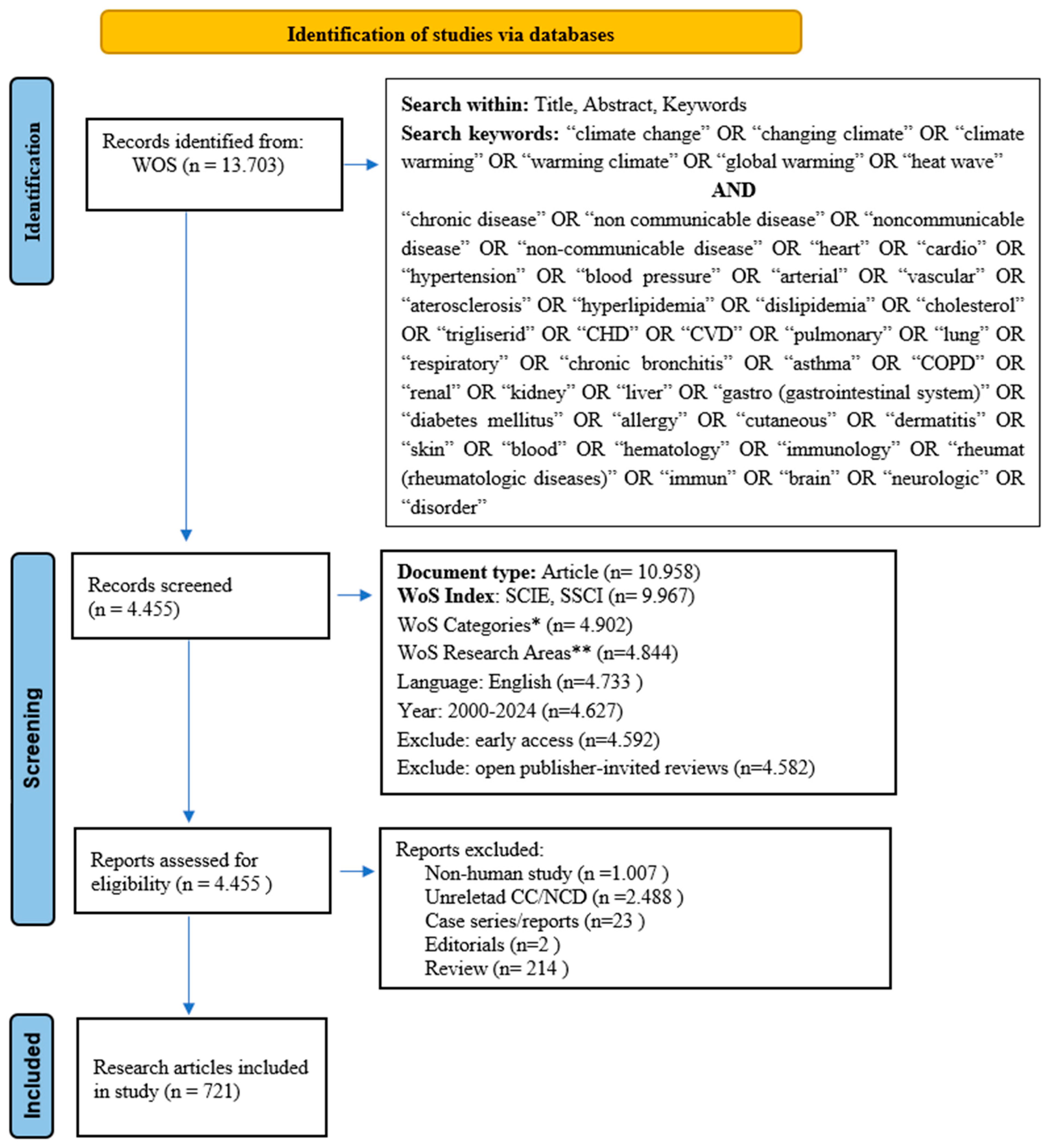
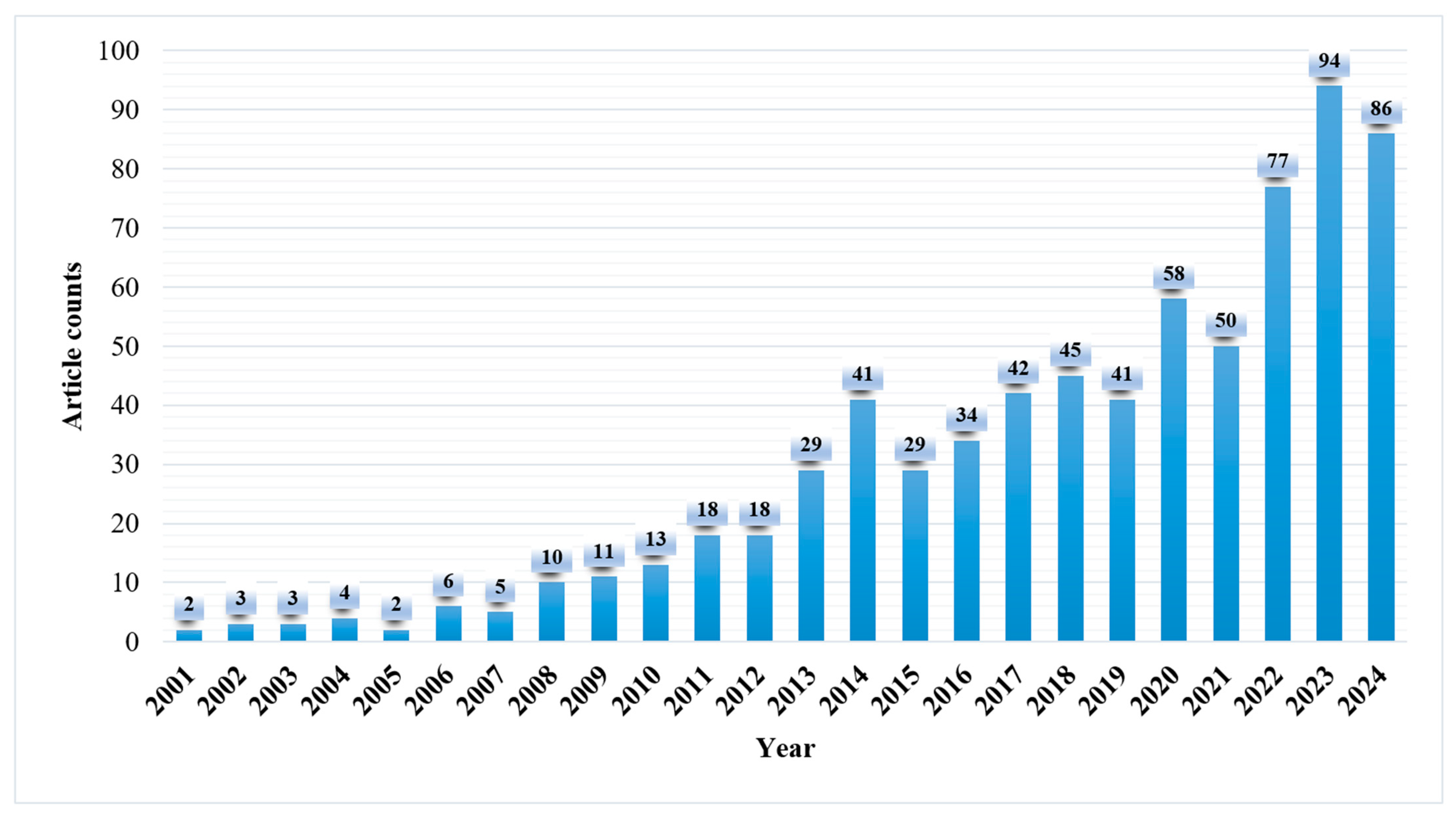
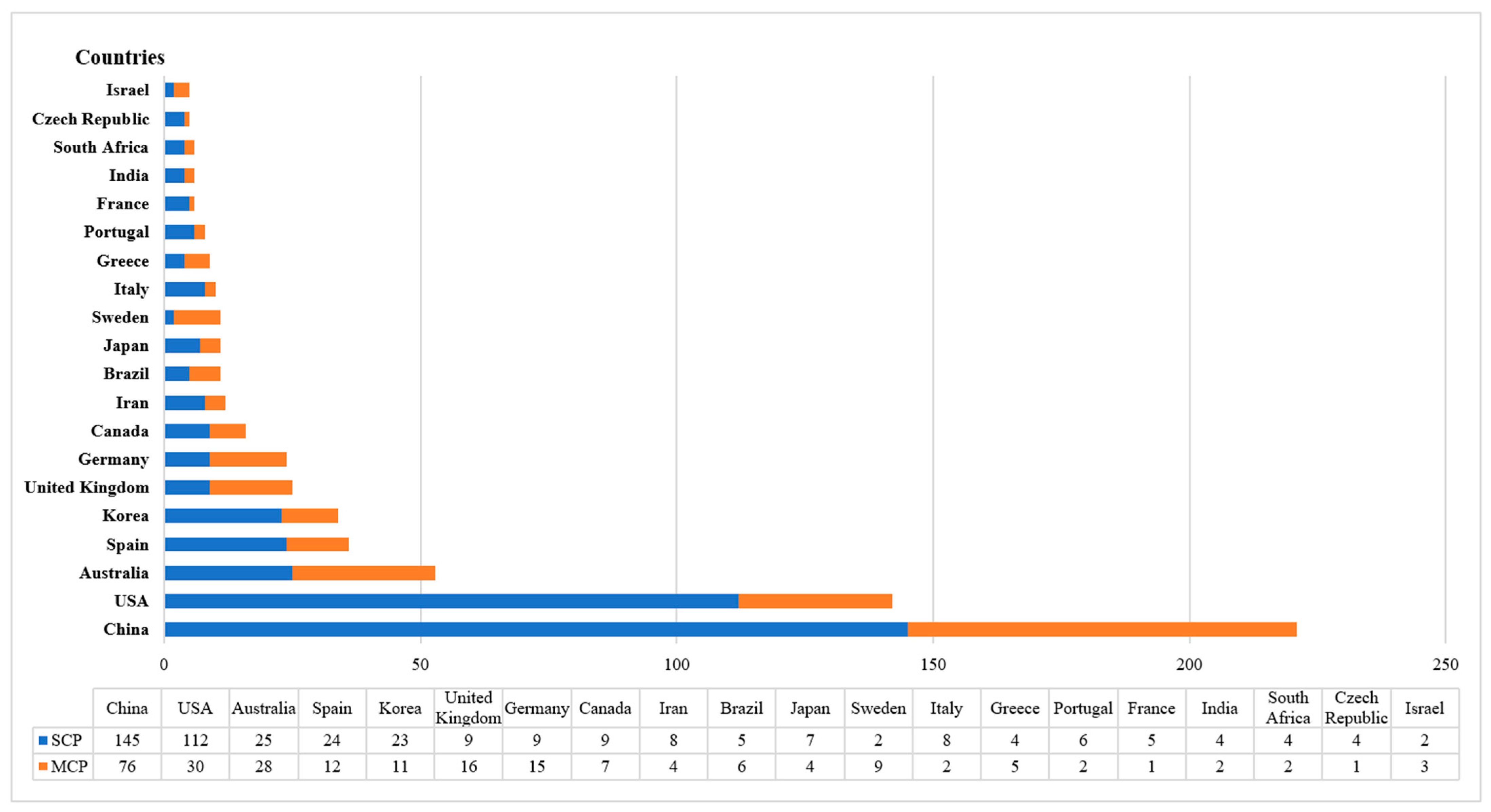
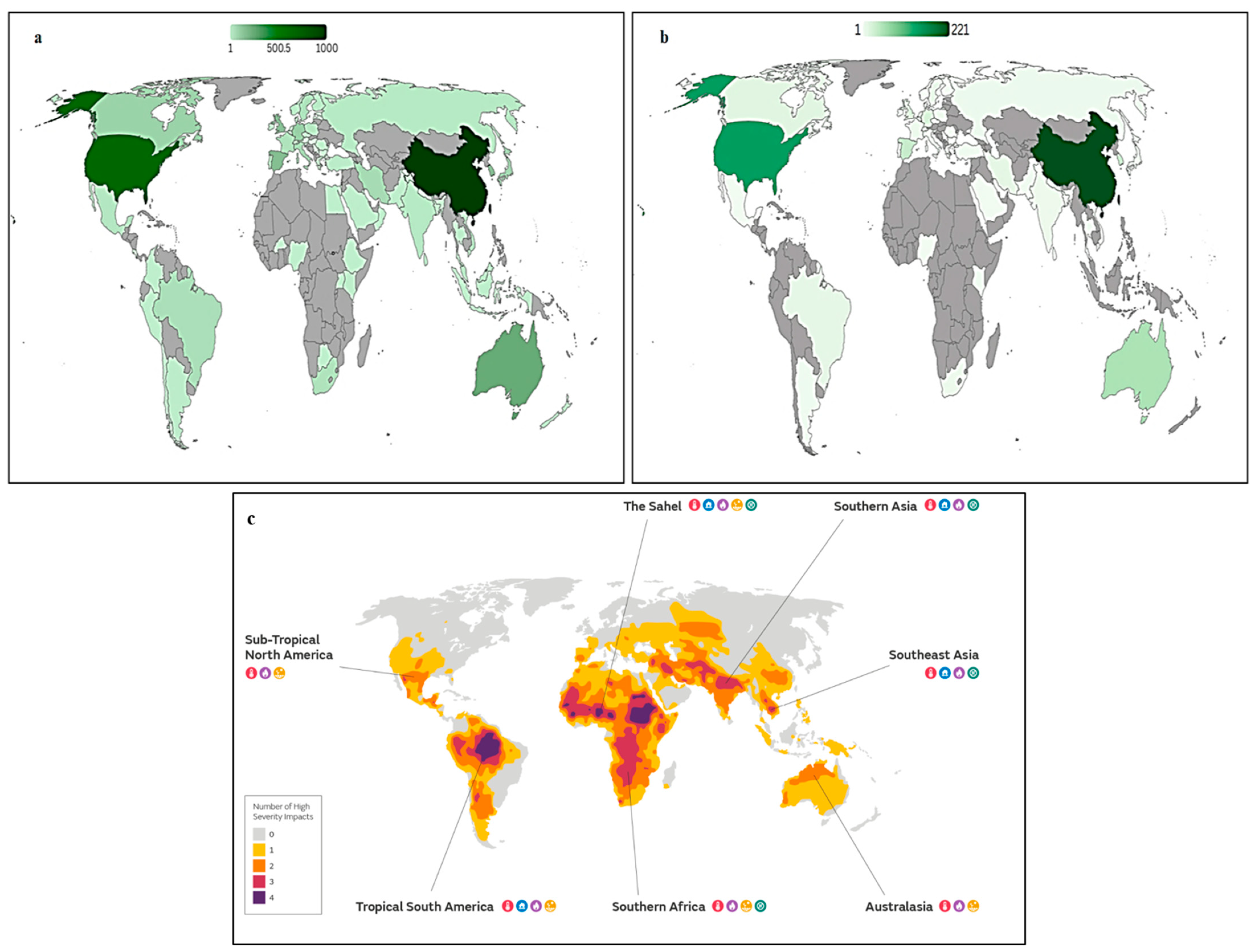
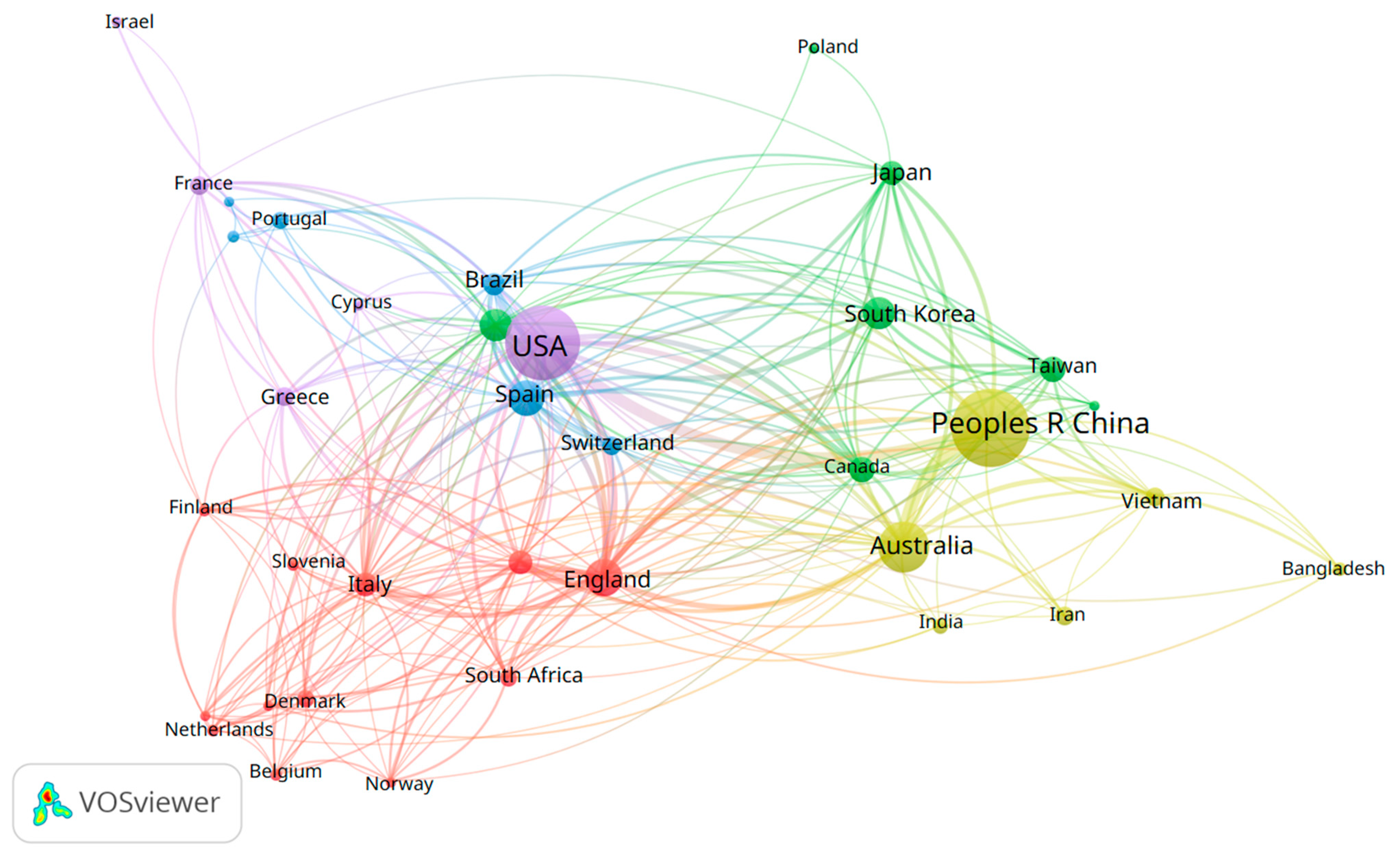
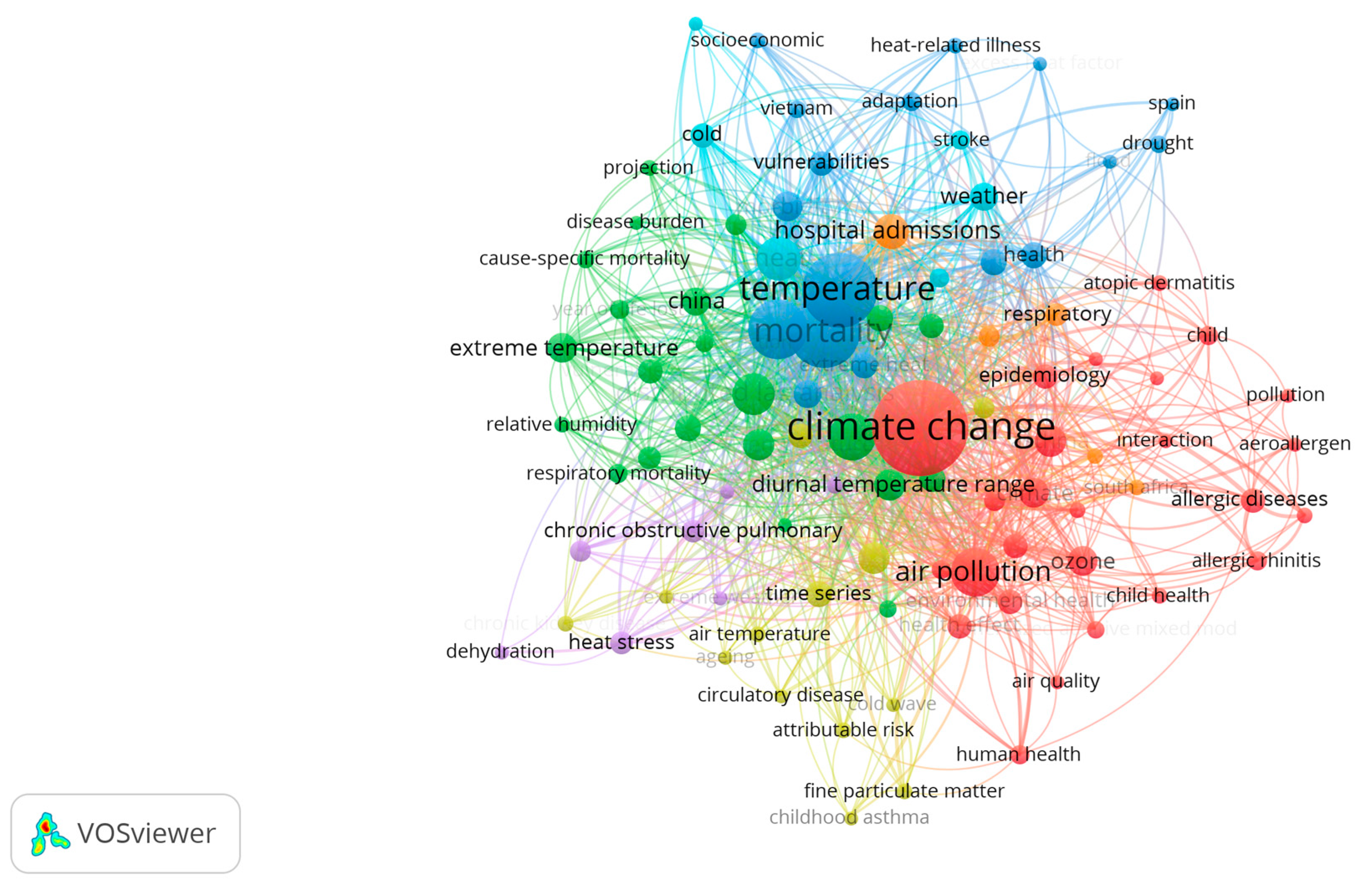
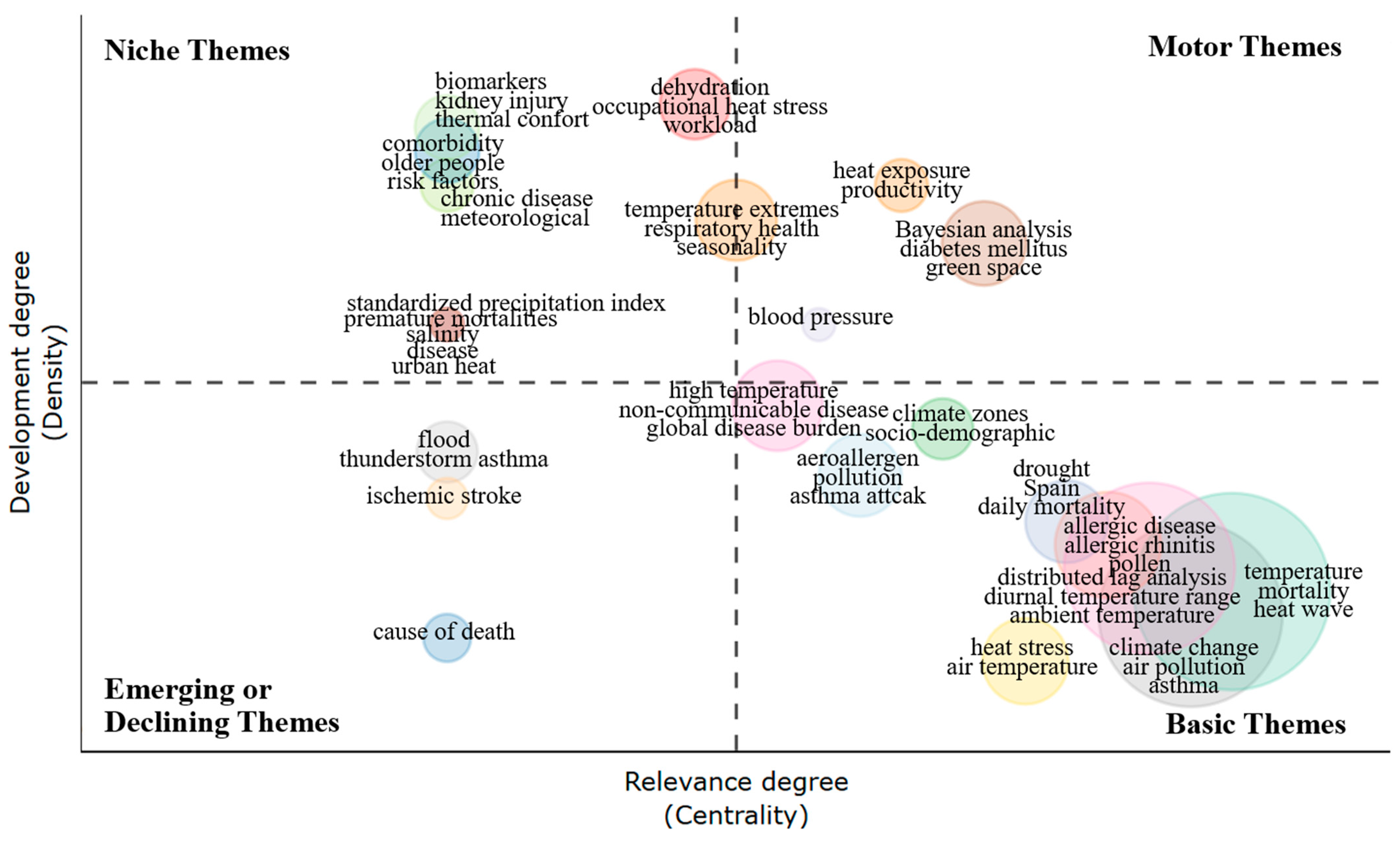
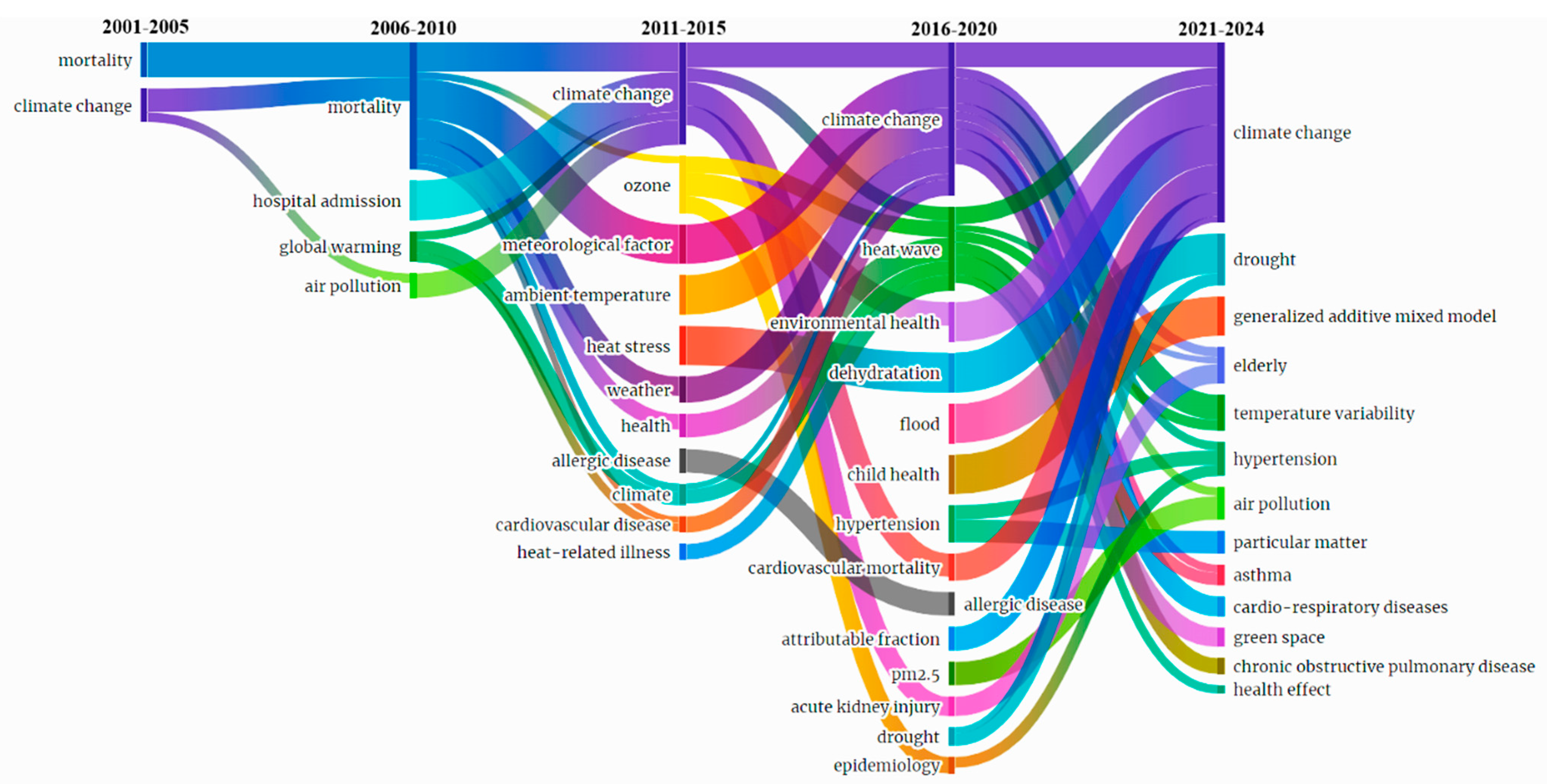
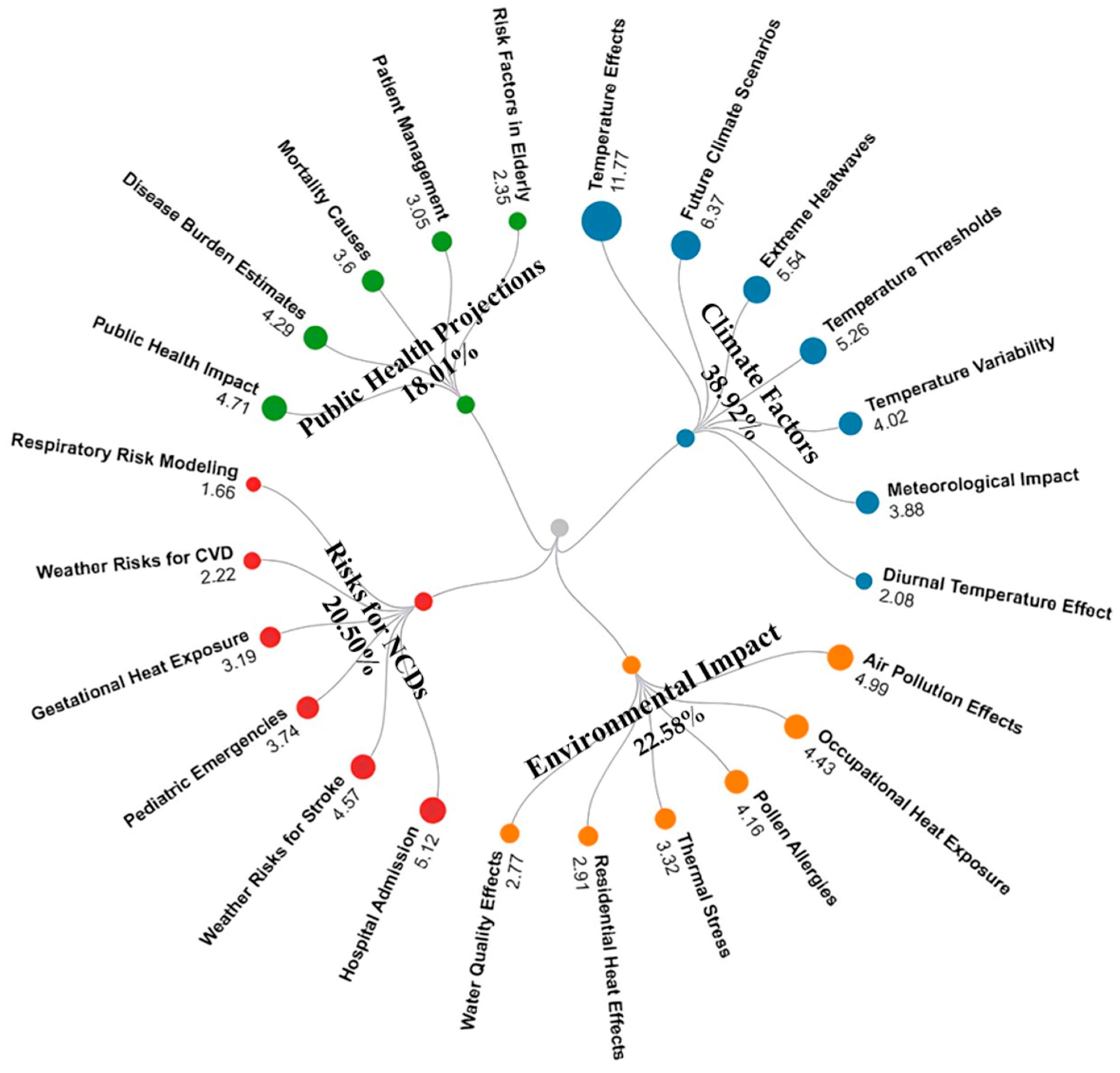
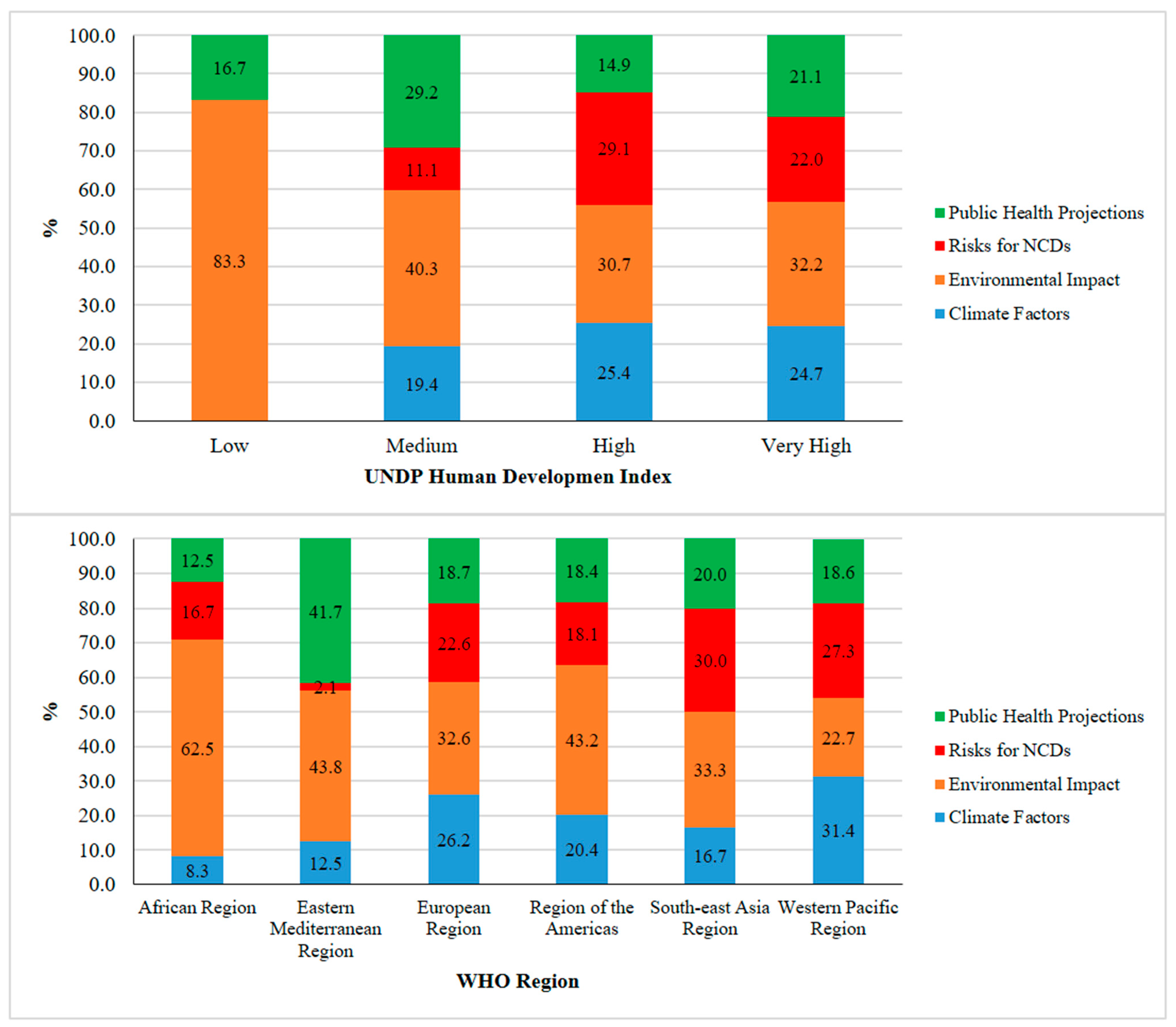
| Journal | Articles | SCIE | SSCI | JIF * |
|---|---|---|---|---|
| Science of The Total Environment | 70 | + | 8.2 | |
| Environmental Research | 53 | + | 7.7 | |
| International Journal of Environmental Research and Public Health | 48 | + | 2.2 | |
| International Journal of Biometeorology | 42 | + | 3 | |
| Environment International | 36 | + | 10.3 | |
| Environmental Science and Pollution Research | 23 | + | 3.5 | |
| Environmental Health Perspectives | 22 | + | 10.1 | |
| Environmental Health | 20 | + | 5.4 | |
| Plos One | 19 | + | 2.9 | |
| Scientific Reports | 19 | + | 3.8 | |
| Bmc Public Health | 14 | + | 3.5 | |
| Environmental Pollution | 12 | + | 7.6 | |
| Urban Climate | 12 | + | 6 | |
| International Journal of Environmental Health Research | 11 | + | 2.2 | |
| Air Quality Atmosphere and Health | 9 | + | 2.9 | |
| Frontiers in Public Health | 9 | + | + | 3 |
| Epidemiology | 7 | + | + | 4.7 |
| Plos Medicine | 7 | + | 10.5 | |
| Bmj Open | 6 | + | 2.4 | |
| Climatic Change | 6 | + | 4.8 |
| Clusters | Keywords | |
|---|---|---|
| Cluster 1 | 26 items, red | climate change, air pollution, asthma, climate, ozone, allergic diseases, environmental health, epidemiology, global warming, health effect, particular matter, human health, pm2.5, allergic rhinitis, child, generalized additive mixed model, pollen, atopic dermatitis, child health, hot temperature, aeroallergen, air quality, cardio-respiratory diseases, interaction, non-communicable disease, pollution |
| Cluster 2 | 22 items, green | cardiovascular disease, distributed lag analysis, diurnal temperature range, ambient temperature, extreme temperature, China, case-crossover, cold spell, emergency admissions, temperature variability, vulnerable groups, cardiovascular mortality, elderly, respiratory mortality, year of life lost, attributable fraction, cause-specific mortality, high temperature, relative humidity, projection, disease burden, lag effect |
| Cluster 3 | 17 items, dark blue | temperature, mortality, heat wave, morbidity, hospitalization, extreme heat, health, public health, vulnerabilities, adaptation, drought, Vietnam, socioeconomic, heat-related illness, excess heat factor, flood, Spain |
| Cluster 4 | 13 items, yellow | respiratory disease, effect modification, emergency, air temperature, attributable risk, chronic kidney disease, fine particulate matter, time series, ageing, childhood asthma, circulatory disease, cold wave, urbanization |
| Cluster 5 | seven items, purple | chronic obstructive pulmonary disease, heat stress, meteorological factor, humidity, dehydration, extreme weather, urban heat island |
| Cluster 6 | six items, light blue | heat, weather, cold, hypertension, stroke, cause of death |
| Cluster 7 | five items, orange | hospital admissions, respiratory, cardiovascular, apparent temperature, South Africa |
| Topic Name | Topic Keywords | Rate |
|---|---|---|
| Temperature Effects | temperature, effect, lag, risk, model, extreme, high, China, distribute, cold, rr (relative risk), relative, day, low, daily | 11.77% |
| Future Climate Scenarios | future, scenario, increase, population, model, project, estimate, emission, projection, disease, health, burden, global, impact, death | 6.37% |
| Extreme Heat Waves | heat, wave, extreme, event, day, effect, impact, increase, risk, period, duration, health, percentile, higher, daily | 5.54% |
| Temperature Thresholds | temperature, degree, increase, daily, day, threshold, cold, ambient, effect, mean, maximum, summer, hot, weather, model | 5.26% |
| Hospital Admission | admission, hospital, disease, increase, kidney, heat wave, morbidity, health, renal, day, temperature, respiratory, emergency, association, injury | 5.12% |
| Air Pollution Effects | air, pollution, ozone, effect, increase, health, respiratory, pollutant, exposure, interaction, concentration, particulate, level, matter, quality | 4.99% |
| Public Health Impact | health, impact, public, environmental, local, outcome, risk, policy, care, disease, adverse, community, report, human, find | 4.71% |
| Weather Risks for Stroke | hospitalization, stroke, risk, increase, association, ischemic, exposure, patient, dust, acute, day, associated, case-crossover, weather, cardiovascular | 4.57% |
| Occupational Heat Exposure | heat, worker, exposure, stress, work, rate, blood, strain, cardiovascular, kidney, function, thermal, outdoor, physiological, compare | 4.43% |
| Disease Burden Estimates | burden, disease, temperature, attributable, COPD (chronic obstructive pulmonary disease), death, high, yll (years of life lost), life, global, fraction, ecu (emergency care utilization), region, rate, estimate | 4.29% |
| Pollen Allergies | pollen, allergic, symptom, season, patient, ad (allergic disease), allergy, concentration, rhinitis, sensitization, tree, skin, grass, count, prevalence | 4.16% |
| Temperature Variability | tv (temperature variability), variability, temperature, exposure, association, disease, increase, flood, cardiovascular, adult, humidity, annual, estimate, long term, emergency | 4.02% |
| Meteorological Impact | drought, meteorological, daily, variable, period, humidity, factor, impact, rainfall, pressure, incidence, region, respiratory, relative, condition | 3.88% |
| Pediatric Emergencies | visit, asthma, emergency, ed (emergency department), department, child, outpatient, childhood, association, patient, hospital, exacerbation, increase, age, relationship | 3.74% |
| Mortality Causes | mortality, death, cause, respiratory, cardiovascular, increase, city, excess, age, all-cause, disease, total, non-accidental, cause-specific, heat | 3.60% |
| Thermal Stress | index, weather, stress, temperature, condition, human, thermal, winter, disease, utcı (universal thermal climate index), health, cardiovascular, type, hot, air | 3.32% |
| Gestational Heat Exposure | exposure, pregnancy, birth, temperature, heat, maternal, association, ambient, associate, outcome, week, risk, increase, woman, gestational | 3.19% |
| Patient Management | patient, factor, risk, disease, consultation, income, illness, incidence, rate, chronic, level, model, control, participant, individual | 3.05% |
| Residential Heat Effects | urban, heat, green, space, vulnerability, rural, increase, island, city, environment, country, population, effect, high, rate | 2.91% |
| Water Quality Effects | water, salinity, effect, child, health, lake, coastal, participant, respiratory, hypertension, increase, bp (blood pressure), pressure, blood, food | 2.77% |
| Risk Factors in Elderly | age, population, disease, risk, older, elderly, individual, group, sex, higher, factor, people, heat, vulnerability, status | 2.35% |
| Weather Risks for CVD | cold, cvd (cardiovascular disease), spell, cardiovascular, disease, rural, effect, association, energy, group, weather, impact, heat, efficiency, apparent | 2.22% |
| Diurnal Temperature Effect | dtr (diurnal temperature range), season, range, age, admission, diurnal, cvd (cardiovascular disease), disease, effect, cardiovascular, hospital, rd (respiratory disease), extremely, tcn (temperature change between neighboring days), er (emergency room) | 2.08% |
| Respiratory Risk Modeling | effect, respiratory, city, health, risk, estimate, different, model, characteristic, level, country, region, compare, modification, potential | 1.66% |
| Topic Name | 2015 | 2016 | 2017 | 2018 | 2019 | 2020 | 2021 | 2022 | 2023 | 2024 | ACC 2015–2024 |
|---|---|---|---|---|---|---|---|---|---|---|---|
| % | % | % | % | % | % | % | % | % | % | ||
| Temperature Variability | 0.00 | 2.94 | 4.76 | 6.67 | 12.20 | 1.72 | 6.00 | 2.60 | 5.32 | 5.81 | ⇑ 0.58 |
| Pollen Allergies | 0.00 | 2.94 | 4.76 | 2.22 | 4.88 | 1.72 | 6.00 | 1.30 | 4.26 | 4.65 | ⇑ 0.47 |
| Residential Heat Effects | 0.00 | 2.94 | 4.76 | 0.00 | 2.44 | 3.45 | 4.00 | 5.19 | 4.26 | 4.65 | ⇑ 0.47 |
| Disease Burden Estimates | 3.45 | 2.94 | 4.76 | 4.44 | 4.88 | 5.17 | 6.00 | 6.49 | 4.26 | 6.98 | ⇑ 0.35 |
| Air Pollution Effects | 3.45 | 2.94 | 7.14 | 2.22 | 4.88 | 3.45 | 4.00 | 5.19 | 3.19 | 6.98 | ⇑ 0.35 |
| Weather Risks for CVD | 0.00 | 2.94 | 0.00 | 0.00 | 2.44 | 1.72 | 0.00 | 1.30 | 6.38 | 3.49 | ⇑ 0.35 |
| Thermal Stress | 0.00 | 0.00 | 0.00 | 4.44 | 0.00 | 6.90 | 8.00 | 3.90 | 5.32 | 3.49 | ⇑ 0.35 |
| Water Quality Effects | 0.00 | 2.94 | 2.38 | 2.22 | 2.44 | 5.17 | 6.00 | 2.60 | 2.13 | 3.49 | ⇑ 0.35 |
| Diurnal Temperature Effect | 0.00 | 2.94 | 0.00 | 0.00 | 2.44 | 0.00 | 4.00 | 3.90 | 3.19 | 3.49 | ⇑ 0.35 |
| Future Climate Scenarios | 6.90 | 8.82 | 4.76 | 6.67 | 7.32 | 10.34 | 4.00 | 3.90 | 5.32 | 9.30 | ⇑ 0.24 |
| Hospital Admission | 3.45 | 8.82 | 7.14 | 6.67 | 4.88 | 5.17 | 8.00 | 1.30 | 5.32 | 5.81 | ⇑ 0.24 |
| Patient Management | 3.45 | 2.94 | 4.76 | 2.22 | 0.00 | 3.45 | 8.00 | 3.90 | 2.13 | 5.81 | ⇑ 0.24 |
| Weather Risks for Stroke | 3.45 | 2.94 | 2.38 | 4.44 | 2.44 | 10.34 | 0.00 | 5.19 | 4.26 | 5.81 | ⇑ 0.24 |
| Gestational Heat Exposure | 0.00 | 0.00 | 4.76 | 2.22 | 4.88 | 0.00 | 2.00 | 5.19 | 8.51 | 2.33 | ⇑ 0.23 |
| Risk Factors in Elderly | 3.45 | 2.94 | 2.38 | 2.22 | 2.44 | 1.72 | 0.00 | 2.60 | 1.06 | 4.65 | ⇑ 0.12 |
| Pediatric Emergencies | 0.00 | 17.65 | 2.38 | 2.22 | 0.00 | 0.00 | 8.00 | 5.19 | 3.19 | 1.16 | ⇑ 0.12 |
| Occupational Heat Exposure | 6.90 | 0.00 | 0.00 | 0.00 | 4.88 | 10.34 | 2.00 | 5.19 | 5.32 | 3.49 | ⇓ −0.34 |
| Extreme Heat Waves | 6.90 | 2.94 | 9.52 | 6.67 | 7.32 | 3.45 | 0.00 | 1.30 | 5.32 | 2.33 | ⇓ −0.46 |
| Public Health Impact | 6.90 | 5.88 | 2.38 | 6.67 | 4.88 | 6.90 | 2.00 | 6.49 | 4.26 | 2.33 | ⇓ −0.46 |
| Respiratory Risk Modeling | 6.90 | 8.82 | 2.38 | 2.22 | 0.00 | 0.00 | 0.00 | 2.60 | 0.00 | 2.33 | ⇓ −0.46 |
| Mortality Causes | 6.90 | 0.00 | 0.00 | 2.22 | 0.00 | 0.00 | 4.00 | 3.90 | 1.06 | 2.33 | ⇓ −0.46 |
| Temperature Effects | 13.79 | 5.88 | 9.52 | 24.44 | 19.51 | 5.17 | 10.00 | 19.48 | 13.83 | 8.14 | ⇓ −0.57 |
| Meteorological Impact | 10.34 | 5.88 | 7.14 | 2.22 | 4.88 | 10.34 | 6.00 | 0.00 | 2.13 | 0.00 | ⇓ −1.03 |
| Temperature Thresholds | 13.79 | 2.94 | 11.90 | 6.67 | 0.00 | 3.45 | 2.00 | 1.30 | 0.00 | 1.16 | ⇓ −1.26 |
| n | % | TCs | ||
|---|---|---|---|---|
| Year | 2001 | 1 | 2 | 466 |
| 2002 | 2 | 4 | 355 | |
| 2003 | 2 | 4 | 286 | |
| 2004 | 2 | 4 | 447 | |
| 2006 | 3 | 6 | 1242 | |
| 2007 | 3 | 6 | 688 | |
| 2008 | 5 | 10 | 1514 | |
| 2009 | 5 | 10 | 1087 | |
| 2010 | 4 | 8 | 947 | |
| 2011 | 3 | 6 | 1168 | |
| 2012 | 4 | 8 | 600 | |
| 2013 | 4 | 8 | 508 | |
| 2014 | 6 | 12 | 1084 | |
| 2015 | 3 | 6 | 1867 | |
| 2016 | 2 | 4 | 503 | |
| 2017 | 1 | 2 | 198 | |
| Affiliation * | University of London | 2 | 4 | 1878 |
| Harvard University | 5 | 10 | 1295 | |
| Yale University | 1 | 2 | 760 | |
| Universite Paris Cite | 1 | 2 | 688 | |
| Athens Medical School | 2 | 4 | 623 | |
| Columbia University | 1 | 2 | 529 | |
| National and Kapodistrian University of Athens | 1 | 2 | 475 | |
| Maastricht University | 1 | 2 | 466 | |
| Australian National University | 1 | 2 | 443 | |
| Seoul National University (SNU) | 3 | 6 | 414 | |
| Chinese Center for Disease Control and Prevention | 2 | 4 | 406 | |
| Complutense University of Madrid | 2 | 4 | 355 | |
| University of Michigan System | 2 | 4 | 312 | |
| Fudan University | 2 | 4 | 307 | |
| Country * | USA | 16 | 32 | 4015 |
| UK | 5 | 10 | 2518 | |
| China | 7 | 14 | 1140 | |
| Greece | 3 | 6 | 1098 | |
| Spain | 5 | 10 | 893 | |
| France | 2 | 4 | 810 | |
| Australia | 2 | 4 | 628 | |
| Netherlands | 2 | 4 | 612 | |
| South Korea | 3 | 6 | 414 | |
| Journal * | Environ Health Persp | 9 | 18 | 2943 |
| Lancet | 2 | 4 | 1828 | |
| Int Arch Occ Env Hea | 3 | 6 | 1014 | |
| Epidemiology | 5 | 10 | 883 | |
| Int J Epidemiol | 3 | 6 | 773 | |
| Occup Environ Med | 2 | 4 | 716 | |
| P Natl Acad Sci Usa | 3 | 6 | 646 | |
| Am J Epidemiol | 2 | 4 | 644 | |
| Sci Total Environ | 4 | 8 | 563 | |
| Environ Health-Glob | 1 | 2 | 491 | |
| Environ Res | 2 | 4 | 307 | |
| Int J Biometeorol | 2 | 4 | 291 |
Disclaimer/Publisher’s Note: The statements, opinions and data contained in all publications are solely those of the individual author(s) and contributor(s) and not of MDPI and/or the editor(s). MDPI and/or the editor(s) disclaim responsibility for any injury to people or property resulting from any ideas, methods, instructions or products referred to in the content. |
© 2025 by the authors. Licensee MDPI, Basel, Switzerland. This article is an open access article distributed under the terms and conditions of the Creative Commons Attribution (CC BY) license (https://creativecommons.org/licenses/by/4.0/).
Share and Cite
Dilaver, I.; Karakullukcu, S.; Gurcan, F.; Topbas, M.; Ursavas, O.F.; Beyhun, N.E. Climate Change and Non-Communicable Diseases: A Bibliometric, Content, and Topic Modeling Analysis. Sustainability 2025, 17, 2394. https://doi.org/10.3390/su17062394
Dilaver I, Karakullukcu S, Gurcan F, Topbas M, Ursavas OF, Beyhun NE. Climate Change and Non-Communicable Diseases: A Bibliometric, Content, and Topic Modeling Analysis. Sustainability. 2025; 17(6):2394. https://doi.org/10.3390/su17062394
Chicago/Turabian StyleDilaver, Irem, Serdar Karakullukcu, Fatih Gurcan, Murat Topbas, Omer Faruk Ursavas, and Nazim Ercument Beyhun. 2025. "Climate Change and Non-Communicable Diseases: A Bibliometric, Content, and Topic Modeling Analysis" Sustainability 17, no. 6: 2394. https://doi.org/10.3390/su17062394
APA StyleDilaver, I., Karakullukcu, S., Gurcan, F., Topbas, M., Ursavas, O. F., & Beyhun, N. E. (2025). Climate Change and Non-Communicable Diseases: A Bibliometric, Content, and Topic Modeling Analysis. Sustainability, 17(6), 2394. https://doi.org/10.3390/su17062394







